![]()
![]()
![]()
Use LEFT and RIGHT arrow keys to navigate between flashcards;
Use UP and DOWN arrow keys to flip the card;
H to show hint;
A reads text to speech;
16 Cards in this Set
- Front
- Back
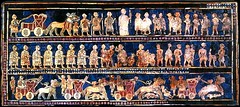
|
The Standard of Ur Royal Cemetery, Ur Sumerian period |
|
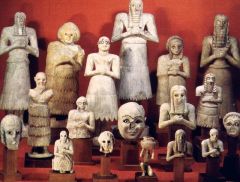
|
Votive Figures 2900-2600 BCE The square Temple, Eshunna Sumerian Period |
|

|
The Warka vase 3300-3000 BCE Urka Sumerian Period |
|

|
The Warka Head 3200-3000 BCE Urka Sumerian Period |
|
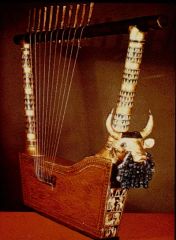
|
The Lyre With Bull’s Head(c. 2550 –2400 B.C.E.) Royal Tomb, Ur Sumerian Period |
|
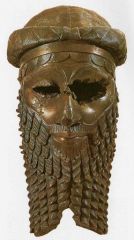
|
Head of Man (c. 2300 –2200 B.C.E.) Nineveh Akkadian Period |
|
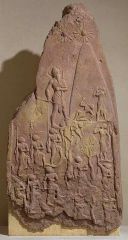
|
Victory Stele of Naram-Sin(c. 2200 –2184 B.C.E.) Sippar, found at Susa. Akkadian Period |
|
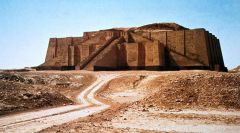
|
Nanna Ziggurat (c. 2100 –2050 B.C.E.) Ur Neo-Sumerian Era |
|
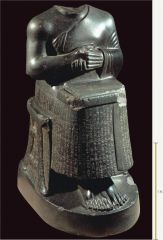
|
Seated Statue of Gudea Holding a Temple Plan (c. 2100 B.C.E.) Girsu Neo-Sumerian Era |
|
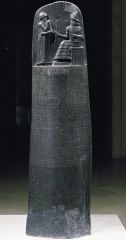
|
Stele of Hammurabi(c. 1792 –1750) Susa (found at present-day Shush, Iran) Old Babylonian Period |
|
|
1. Map of the Ancient Near East “What” language does the word “Mesopotamia” originate from and “what” does the word mean, when translated? BE SPECIFIC. “What” made life possible in Mesopotamia (the “Fertile Crescent”); what was special about this region (***formulate your answer in relation to the previous question***)? BE SPECIFIC. “Why” is the language from which the word “Mesopotamia” originates important to our understanding of the history of the Ancient Near East? (HINT: Who will conquer this region later, in the 4th century B.C.E.). EXPLAIN and BE SPECIFIC. |
-Mesopotamia is Greek for land between the Rivers - Mesopotamia was situated between the Tigris and Euphrates rivers creating a rich fertile land -Alexander the Great would conquer this region in 356-300 BCE he would spread his Greek ideals |
|
|
2 The Warka Vase Consider what you know about the region of Mesopotamia and the fact that this vase is carved from stone. “Why” is the material (stone) significant? EXPLAIN AND BE SPECIFIC. The visual imagery on this vase is divided through the use of REGISTERS. “What” are REGISTERS? BE SPECIFIC. This imagery on this vase is displaying a narrative (telling some kind of story). “How” do the registers interact with one another (where does the narrative begin) and “what” is the (generally accepted) story being told? EXPLAIN AND BE SPECIFIC. HIERATIC SCALE (a.k.a. “Hierarchy” or “Hierarchical Scale”) is being used on this vase. “What” is HIERATIC SCALE (what does it look like, what does it imply, etc.). EXPLAIN AND BE SPECIFIC. |
-the vase was made of alabaster stone that was not available in this region, so needed to be imported. stone carvings would have only been done for only very important people or Gods -Registers are horizontal bands read from bottom to top. -The registers all tell a story of fertility. The story starts on the bottom register and continues up to the top where it shows the Goddess Inanna being given offerings from nude priests -The goddess is shown larger than all other figures. this is hierarcy and shows Inanna's importance |
|
|
3 Votive Figures “Whom” were these Votive Figures meant to represent? BE SPECIFIC. “What” was the theorized purpose of Votive Figures (like those found in the Square Temple, in what is now Iraq)? “WHY” were they created (what was their function)? EXPLAIN and BE SPECIFIC. Use SPECIFIC visual evidence to EXPLAIN and SUPPORT your answer. |
-They represented the donor of the Gods gifts, not meant to be an exact likeness -They were a gift to the Gods to remind them of the person's perpetual devotion -The figures often have overly large eyes to represent the perpetual wakefulness of the worshiper offering prayers to the Gods |
|
|
4 Head of a Man-Head of Sargon Whenever an artifact or work, made of metal (in this case, copper), survives from the ancient past it is considered to be a “big deal”. WHY? EXPLAIN and BE SPECIFIC. ‘Why’ was the Head of a Man (a.k.a. Head of an Akkadian Ruler) mutilated (what are the theories: list at least two (2))? EXPLAIN and BE SPECIFIC. This sculpture is an example of one of the earliest known “what” (Hint: what technique was used to create the work of art)? BE SPECIFIC. |
-When a city or land was conquered the symbols of previous rulers would be melted down to be used again -The head would have been mutilated for a political statement. It could also have been lotted for precious stones in the eyes -The sculpture is the earliest example of hollow cast method. the lost wax method of using a clay core with a wax layer than another clay layer. metal was then poured in replacing the wax. The clay would then be broken off when it cooled. |
|
|
5 Nanna Ziggurat Ziggurats are common religious structures from ancient Mesopotamia that originated with the Sumerians but became widely adopted by other cultures in this region. “What”, exactly, is a Ziggurat (“how” would you define/describe what this structure is; make sure you consider 1) appearance, 2) materials, 3)location, 4) function, etc.)? BE SPECIFIC. The Nanna Ziggurat, like the White Temple at Uruk, was constructed in a flat region and would have been visible for miles. “What” would the benefit have been for constructing such large dominating structures (“why” would their visibility from great distances have been important)? EXPLAIN. The Nanna Ziggurat was dedicated to the Sumerian moon deity, Nanna. The Sumerians (like many of the peoples and cultures we will be discussing in this class) were a POLYTHEISTIC society. “What” does the term POLYTHEISTIC mean? BE SPECIFIC. |
-The ziggurat is a tiered platform with a temple on the top. It has a mud brick core with an outer layer of baked bricks glued together with bitumen -The zigguat was part of a temple complex that was an administrative center for the city. It was a shrine to the moon God Nanna. -The height of the zigguat would have been visible for miles and was a focal point for travelers and the pious worshipers. -Polytheistic means a person believes in many Gods. |
|
|
6 Seated Statue of Gudea holding a Temple plan Gudea was a prince of Lagash during the era AFTER the fall of the Akkadians (an era of Sumerian revival). Over two dozen “portraits” of Gudea survive and the way he is depicted (in these “portraits”) contrasts with the Akkadian concept of Kingship. “What” visual imagery supports this statement (“how” do the images of Gudea compare to how the Akkadians portrayed their rulers)? BE SPECIFIC (use SPECIFIC visual evidence). “What” is significant about the temple plan that Gudea has on his lap (“why” is this an important element of this sculpture)? BE SPECIFIC. All of the sculptures of Gudea that survive (including this work of art) are made of DIORITE. “What” is DIORITE and “why” is it significant that Gudea would wish for all his votive portraits to be made from this material? BE SPECIFIC. |
-Gudea was a humble man- he is portrayed with his hands clasped and barefoot with a shepherds hat -The blueprints he holds in his lap are the plans to a new temple dedicated to Nigirsu - He rebuilt temples that were neglected and desecrated -Diorite is a rare and costly dark stone. It is extreemly hard which makes it difficult to carve -an inscription on one of his statues says;"this statue has not been made from silver nor from Lapis lazuli, nor from copper nor from lead,nor yet from bronze; it is made of diorite." Shows how important he was. |

